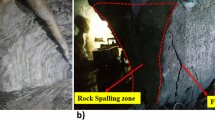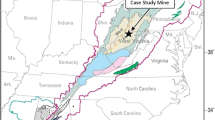Abstract
An imperative task for successful underground mining is to ensure the stability of underground structures. This is more so for deep excavations which may be under significantly high stresses. In this manuscript, we present stability studies on two tunnels, a horseshoe-shaped and an inverted arch-shaped tunnel, in a deep coal mine in China, performed using the 3DEC distinct element code. The rock mass mechanical property values for the tunnel shapes have been estimated through a back-analysis procedure using available field deformation data. The back-analysis has been carried out through a pseudo-time dependent support installation routine which incorporates the effect of time through a stress-relaxation mechanism. The back-analysis indicates that the rock mass cohesion, tensile strength, uniaxial compressive strength, and elastic modulus values are about 35–45 % of the corresponding intact rock property values. Additionally, the importance of incorporating stress relaxation before support installation has been illustrated through the increased support factor of safety and reduced grout failures. The calibrated models have been analyzed for different supported and unsupported cases to estimate the significance and adequacy of the current supports being used in the mine and to suggest a possible optimization. The effects of supports have been demonstrated using deformations and yield zones around the tunnels, and average factors of safety and grout failures of the supports. The use of longer supports and floor bolting has provided greater stability for the rock masses around the tunnels. Finally, a comparison between the two differently shaped tunnels establishes that the inverted arch tunnel may be more efficient in reducing roof sag and floor heave for the existing geo-mining conditions.

























Similar content being viewed by others
References
Aldorf J, Exner K (2013) Mine openings: stability and support. Elsevier, Oxford
Barla G, Barla M (2000) Continuum and discontinuum modelling in tunnel engineering. Min Geol Pet Eng Bull 12:45–57
Brown ET, Bray JW, Ladanyi B, Hoek E (1983) Ground response curves for rock tunnels. J Geotech Eng 109(1):15–39
Cheng YM (1998) Advancements and improvement in discontinuous deformation analysis. Comput Geotech 22(2):153–163. doi:10.1016/S0266-352X(98)00002-0
China Coal Society Open Pit Mine Committee (2010) China Open Pit Coalmining Development Report (1914–2007). China Coal Industry Publishing House, Beijing
Coggan J, Gao F, Stead D, Elmo D (2012) Numerical modelling of the effects of weak immediate roof lithology on coal mine roadway stability. Int J Coal Geol 90:100–109
Compiling Committee of China (2010) China Coal Industry yearbook 2009. China Coal Industry Press, Beijing
Cundall PA (1971) A computer model for simulating progressive, large-scale movements in blocky rock systems. In: The international symposium on rock mechanics, 2, pp 47–65
Cundall PA (2001) A discontinuous future for numerical modelling in geomechanics? Proc ICE Geotech Eng 149(1):41–47
Deb D, Das KC (2010) Extended finite element method for the analysis of discontinuities in rock masses. Geotech Geol Eng 28(5):643–659
Eberhardt E, Stead D, Coggan J, Willenberg H (2003) Hybrid finite-/discrete-element modelling of progressive failure in massive rock slopes. In: Handley M, Stacey D (eds) 10th Congress of the international society for rock mechanics (pp 275–280). Johannesburg: The South African Institute of Mining and Metallurgy. http://www.eoas.ubc.ca/personal/erik/e-papers/03EE_ISRMCongress-Elfen.pdf
Elmo D (2006) Evaluation of a hybrid FEM/DEM approach for determination of rock mass strength using a combination of discontinuity mapping and fracture mechanics modelling, with particular emphasis on modelling of jointed pillars. (Unpublished Ph.D. Dissertation). University of Exeter, Exeter UK
Elmo D, Stead D (2010) An integrated numerical modelling–discrete fracture network approach applied to the characterisation of rock mass strength of naturally fractured pillars. Rock Mech Rock Eng 43(1):3–19
Elmo D, Stead D, Eberhardt E, Vyazmensky A (2013) Applications of finite/discrete element modeling to rock engineering problems. Int J Geomech 13(5):565–580. doi:10.1061/(ASCE)GM.1943-5622.0000238
Fairhurst C, Pei J (1990) A comparison between the distinct element method and the finite element method for analysis of the stability of an excavation in jointed rock. Tunn Undergr Space Technol 5(1–2):111–117. doi:10.1016/0886-7798(90)90066-S
Ghee EH, Zhu BT, Wines DR (2006) Numerical analysis of twin road tunnels using two-and three-dimensional modelling techniques. In: Fourth International FLAC symposium on numerical modelling in geomechanics
Hamdi P, Stead D, Elmo D (2014) Damage characterization during laboratory strength testing: a 3D-finite-discrete element approach. Comput Geotech 60:33–46. doi:10.1016/j.compgeo.2014.03.011
Hao YH, Azzam R (2005) The plastic zones and displacements around underground openings in rock masses containing a fault. Tunn Undergr Space Technol 20:41–61. doi:10.1016/j.tust.2004.05.003
He X, Song L (2012) Status and future tasks of coal mining safety in China. Saf Sci 50(4):894–898. doi:10.1016/j.ssci.2011.08.012
Hoek E, Kaiser PK, Bawden WF (2000) Support of underground excavations in hard rock. CRC Press, Boca Raton
Huang S (2008) China Coal Outlook 2009. China coal industry publishing house, Beijing
Itasca (2008) 3DEC user’s guide. Itasca Consulting Group Inc., Minnesota
Jian-ping Z, Ren-ke W, Ai-min W, Yang L, Wang Z (2012) Optimization support controlling large deformation of tunnel in deep mine based on discontinuous deformation analysis. Procedia Environ Sci 12(Icese 2011):1045–1054. doi:10.1016/j.proenv.2012.01.386
Kang Y, Liu Q, Gong G, Wang H (2014) Application of a combined support system to the weak floor reinforcement in deep underground coal mine. Int J Rock Mech Min Sci 71:143–150
Kulatilake PHSW, Ucpirti H, Wang S, Radberg G, Stephansson O (1992) Use of the distinct element method to perform stress analysis in rock with non-persistent joints and to study the effect of joint geometry parameters on the strength and deformability of rock masses. Rock Mech Rock Eng 25(4):253–274
Kulatilake PHSW, Wang S, Stephansson O (1993) Effect of Finite Size Joints on the deformability of jointed rock in three dimensions. Int J Rock Mech Min Sci Geomech Abstr 30(5):479–501
Kulatilake PHSW, Park J, Um JG (2004) Estimation of rock mass strength and deformability in 3-D for a 30 m cube at a depth of 485 m at Äspö hard rock laboratory. Geotech Geol Eng 22(3):313–330
Lisjak A, Grasselli G, Vietor T (2014) Continuum-discontinuum analysis of failure mechanisms around unsupported circular excavations in anisotropic clay shales. Int J Rock Mech Min Sci 65:96–115. doi:10.1016/j.ijrmms.2013.10.006
Ma YM (1999) Development of discontinuous deformation analysis the first 10 years (1986–1996). In: Proceedings third international conference on analysis of discontinuous deformation, Vail, Colorado, USA, pp 17–32
Macklin SR, Varley P, Varona P, Merino C (2012) The investigation and design for a unique architectural space—the Chillida Cavern, Mount Tindaya, Fuerteventura. Tunn Undergr Space Technol 31:9–19. doi:10.1016/j.tust.2012.04.001
MacLaughlin MM, Doolin DM (2006) Review of validation of the discontinuous deformation analysis (DDA) method. Int J Numer Anal Meth Geomech 30(4):271–305. doi:10.1002/nag.427
Mahabadi OK, Lisjak A, Munjiza A, Grasselli G (2012) Y-Geo : new combined finite-discrete element numerical code for geomechanical applications. Int J Geomech 12(6):676–688. doi:10.1061/(ASCE)GM.1943-5622.0000216
Mark C, Barczak TM (2000) Fundamentals of coal mine roof support. In: New Technology for Coal Mine Roof Support, Proceedings of the NIOSH open industry briefing, NIOSH IC, vol 9453. pp 23–42
Munjiza A, Owen DRJ, Bicanic N (1995) A combined finite-discrete element method in transient dynamics of fracturing solids. Eng Comput 12(2):145–174
Ohnishi Y, Sasaki T, Koyama T, Hagiwara I, Miki S, Shimauchi T (2014) Recent insights into analytical precision and modelling of DDA and NMM for practical problems. Geomech Geoeng 9(2):97–112
Peng SS, Tang DHY (1984) Roof bolting in underground mining: a state-of-the-art review. Int J Min Eng 2(1):1–42
Price DG (2008) In: De Freitas MH (ed) Engineering geology: principles and practice. Springer, Berlin
Racine JS (2012) RStudio: a platform-independent IDE for R and Sweave. J Appl Econom 27(1):167–172
Rockfield Software Ltd (2011) Elfen User manual. Swansea, UK
Scheldt T (2003) Comparison of continuous and discontinuous modelling for computational rock mechanics. Doctoral Dissertation, Norwegian University of Science and Technology
Shan XY, Mei HB, Xu DQ, Zhao YX (2005) Mining-induced influences on stability of floor haulage roadway in tectonic stress field. Yanshilixue Yu Gongcheng Xuebao/Chin/J Rock Mech Eng 24(12):2101–2106
Shi G (2007) Applications of discontinuous deformation analysis (DDA) to rock engineering. In: International seminar on computational mechanics (ISCM 2007) (pp 136–147)
Shi GH (2014) Application of discontinuous deformation analysis on stability analysis of slopes and underground power houses. Geomech Geoeng 9(2):80–96. doi:10.1080/17486025.2013.871065
Shi GH, Goodman RE (1985) Two dimensional discontinuous deformation analysis. Int J Numer Anal Meth Geomech 9(6):541–556. doi:10.1002/nag.1610090604
Singh R, Mandal PK, Singh AK, Singh TN (2001) Cable-bolting-based semi-mechanised depillaring of a thick coal seam. Int J Rock Mech Min Sci 38(2):245–257
Vardakos SS, Gutierrez MS, Barton NR (2007) Back-analysis of Shimizu Tunnel No. 3 by distinct element modeling. Tunn Undergr Space Technol 22(4):401–413. doi:10.1016/j.tust.2006.10.001
Vyazmensky A, Elmo D, Stead D (2010) Role of rock mass fabric and faulting in the development of block caving induced surface subsidence. Rock Mech Rock Eng 43(5):533–556
Wang X, Kulatilake PHSW, Song WD (2012) Stability investigations around a mine tunnel through three-dimensional discontinuum and continuum stress analyses. Tunn Undergr Space Technol 32:98–112
Wu Q, Kulatilake PHSW (2012) Application of equivalent continuum and discontinuum stress analyses in three-dimensions to investigate stability of a rock tunnel in a dam site in China. Comput Geotech 46:48–68
Wu JH, Ohnishi Y, Shi G, Nishiyama S (2005) Theory of three-dimensional discontinuous deformation analysis and its application to a slope toppling at Amatoribashi, Japan. Int J Geomech 5(3):179–195
Xiao TQ, Bai JB, Wang XY, Chen Y, Yu Y (2011) Stability principle and control of surrounding rock in deep coal roadway with large section and thick top-coal. Rock Soil Mech 32(6):1874–1880
Yuyong J, Jian Z (2004) On using DEM for simulating response of jointed rock to underground explosion. Chin J Rock Mech Eng 23(2):5
Zhao ZY, Bao HR, Tian Q (2011) On the complementation of augmented Lagrangian method in the 2D discontinuous deformation analysis. In: Zhao J, Ohnishi Y, Zhao GF, Sasaki T (eds) Advances in discontinuous numerical methods and applications in geomechanics and geoengineering, ICADD10, HA. CRC Press, pp 181–187
Acknowledgments
The research was funded by the US Centers for Disease Control and Prevention under the Contract No. 200-2011-39886. The authors would like to thank Xiezhuang Coal Mine and Dr. Zhengxing Yu and Professor Fuxing Jiang of University of Science and Technology Beijing for providing laboratory and field geological and geotechnical data for this research. The authors further thank the Xiezhuang Coal Mine for providing the encouragement to conduct this research and to publish the research findings.
Author information
Authors and Affiliations
Corresponding author
Rights and permissions
About this article
Cite this article
Shreedharan, S., Kulatilake, P.H.S.W. Discontinuum–Equivalent Continuum Analysis of the Stability of Tunnels in a Deep Coal Mine Using the Distinct Element Method. Rock Mech Rock Eng 49, 1903–1922 (2016). https://doi.org/10.1007/s00603-015-0885-9
Received:
Accepted:
Published:
Issue Date:
DOI: https://doi.org/10.1007/s00603-015-0885-9




